Employee Retention Challenges and HR Practices in Australian Education
VerifiedAdded on 2022/10/11
|12
|3340
|7
Report
AI Summary
This report delves into the multifaceted challenges of employee retention within the Australian education sector. It begins by defining employee retention and its importance, highlighting the negative impacts of employee turnover and the significance of a motivated workforce. The report identifies key issues such as increasing competition, changing government policies, and poor remuneration as significant contributors to employee attrition. It explores the structure of the Australian education system, including early childhood, primary, secondary, and tertiary education, and discusses the problems the sector faces, such as budget cuts, market saturation, and the need for continuous learning. The report further examines the role of human resource planning, strategic human resource management, and industrial relations frameworks in addressing these challenges. It emphasizes the importance of work-life balance, fair work practices, and the impact of globalization and political changes on the workforce. The report also discusses the Fair Work Act and its implications for employee-employer relations, including minimum wages and collective bargaining. Overall, the report underscores the need for effective human resource management strategies to attract, retain, and support employees in the dynamic Australian education sector.
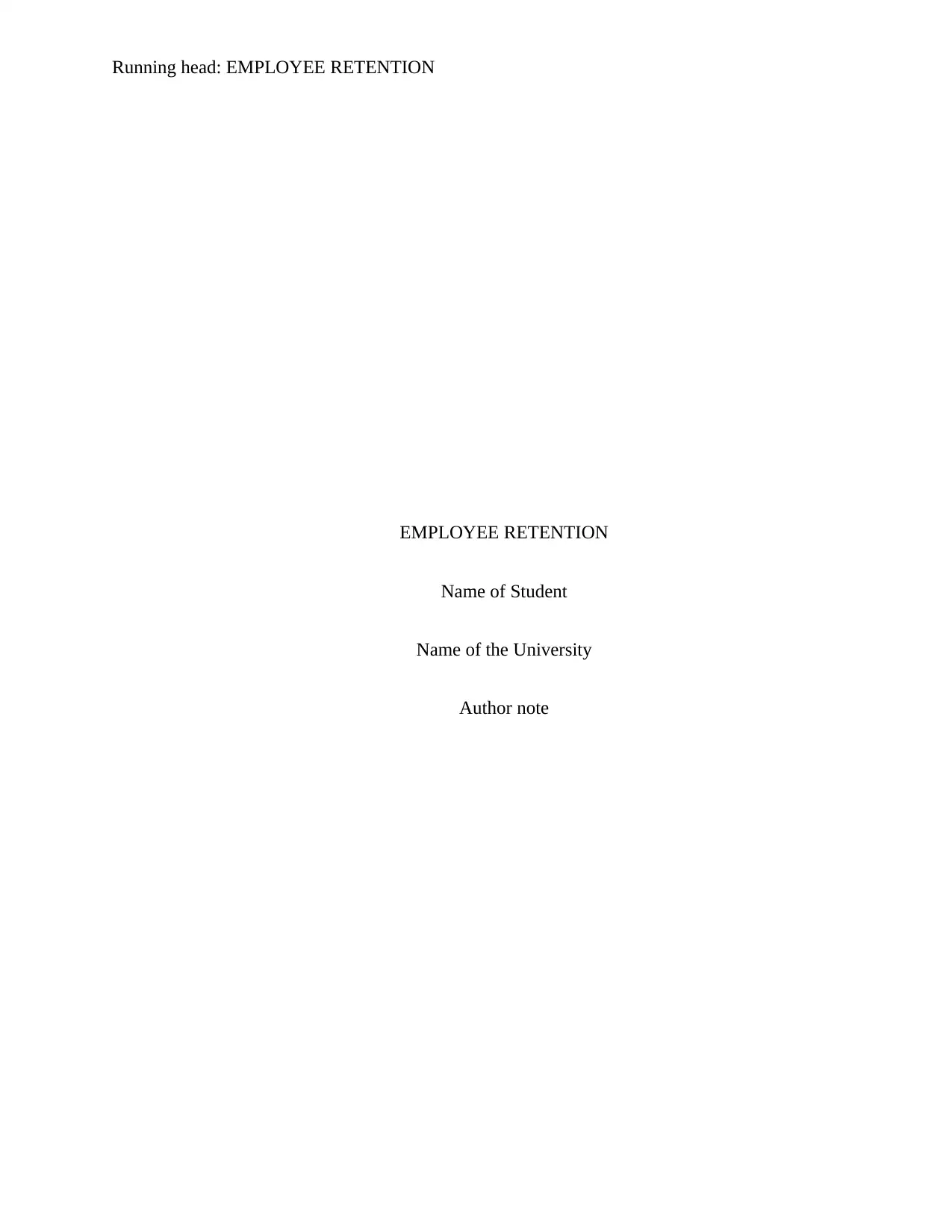
Running head: EMPLOYEE RETENTION
EMPLOYEE RETENTION
Name of Student
Name of the University
Author note
EMPLOYEE RETENTION
Name of Student
Name of the University
Author note
Paraphrase This Document
Need a fresh take? Get an instant paraphrase of this document with our AI Paraphraser
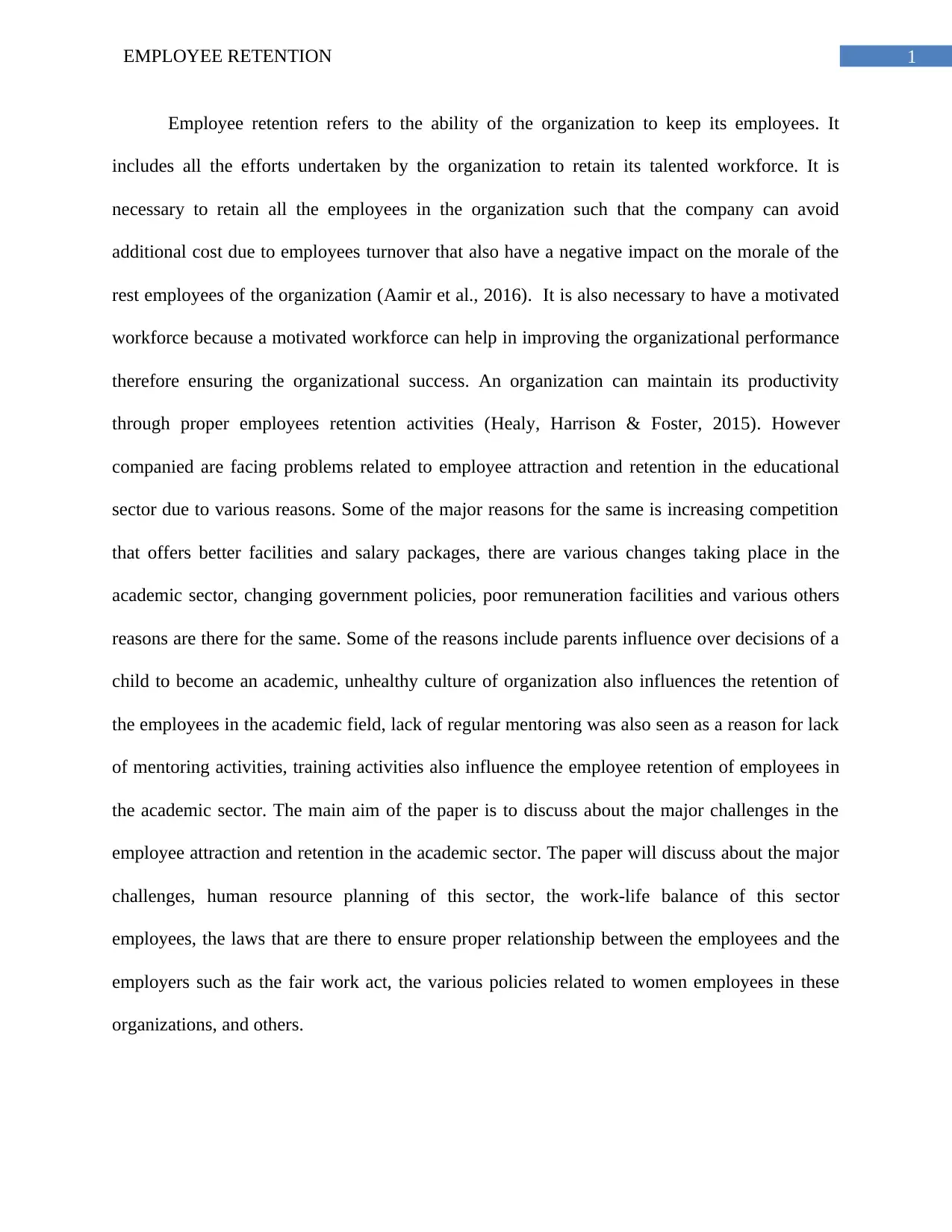
1EMPLOYEE RETENTION
Employee retention refers to the ability of the organization to keep its employees. It
includes all the efforts undertaken by the organization to retain its talented workforce. It is
necessary to retain all the employees in the organization such that the company can avoid
additional cost due to employees turnover that also have a negative impact on the morale of the
rest employees of the organization (Aamir et al., 2016). It is also necessary to have a motivated
workforce because a motivated workforce can help in improving the organizational performance
therefore ensuring the organizational success. An organization can maintain its productivity
through proper employees retention activities (Healy, Harrison & Foster, 2015). However
companied are facing problems related to employee attraction and retention in the educational
sector due to various reasons. Some of the major reasons for the same is increasing competition
that offers better facilities and salary packages, there are various changes taking place in the
academic sector, changing government policies, poor remuneration facilities and various others
reasons are there for the same. Some of the reasons include parents influence over decisions of a
child to become an academic, unhealthy culture of organization also influences the retention of
the employees in the academic field, lack of regular mentoring was also seen as a reason for lack
of mentoring activities, training activities also influence the employee retention of employees in
the academic sector. The main aim of the paper is to discuss about the major challenges in the
employee attraction and retention in the academic sector. The paper will discuss about the major
challenges, human resource planning of this sector, the work-life balance of this sector
employees, the laws that are there to ensure proper relationship between the employees and the
employers such as the fair work act, the various policies related to women employees in these
organizations, and others.
Employee retention refers to the ability of the organization to keep its employees. It
includes all the efforts undertaken by the organization to retain its talented workforce. It is
necessary to retain all the employees in the organization such that the company can avoid
additional cost due to employees turnover that also have a negative impact on the morale of the
rest employees of the organization (Aamir et al., 2016). It is also necessary to have a motivated
workforce because a motivated workforce can help in improving the organizational performance
therefore ensuring the organizational success. An organization can maintain its productivity
through proper employees retention activities (Healy, Harrison & Foster, 2015). However
companied are facing problems related to employee attraction and retention in the educational
sector due to various reasons. Some of the major reasons for the same is increasing competition
that offers better facilities and salary packages, there are various changes taking place in the
academic sector, changing government policies, poor remuneration facilities and various others
reasons are there for the same. Some of the reasons include parents influence over decisions of a
child to become an academic, unhealthy culture of organization also influences the retention of
the employees in the academic field, lack of regular mentoring was also seen as a reason for lack
of mentoring activities, training activities also influence the employee retention of employees in
the academic sector. The main aim of the paper is to discuss about the major challenges in the
employee attraction and retention in the academic sector. The paper will discuss about the major
challenges, human resource planning of this sector, the work-life balance of this sector
employees, the laws that are there to ensure proper relationship between the employees and the
employers such as the fair work act, the various policies related to women employees in these
organizations, and others.
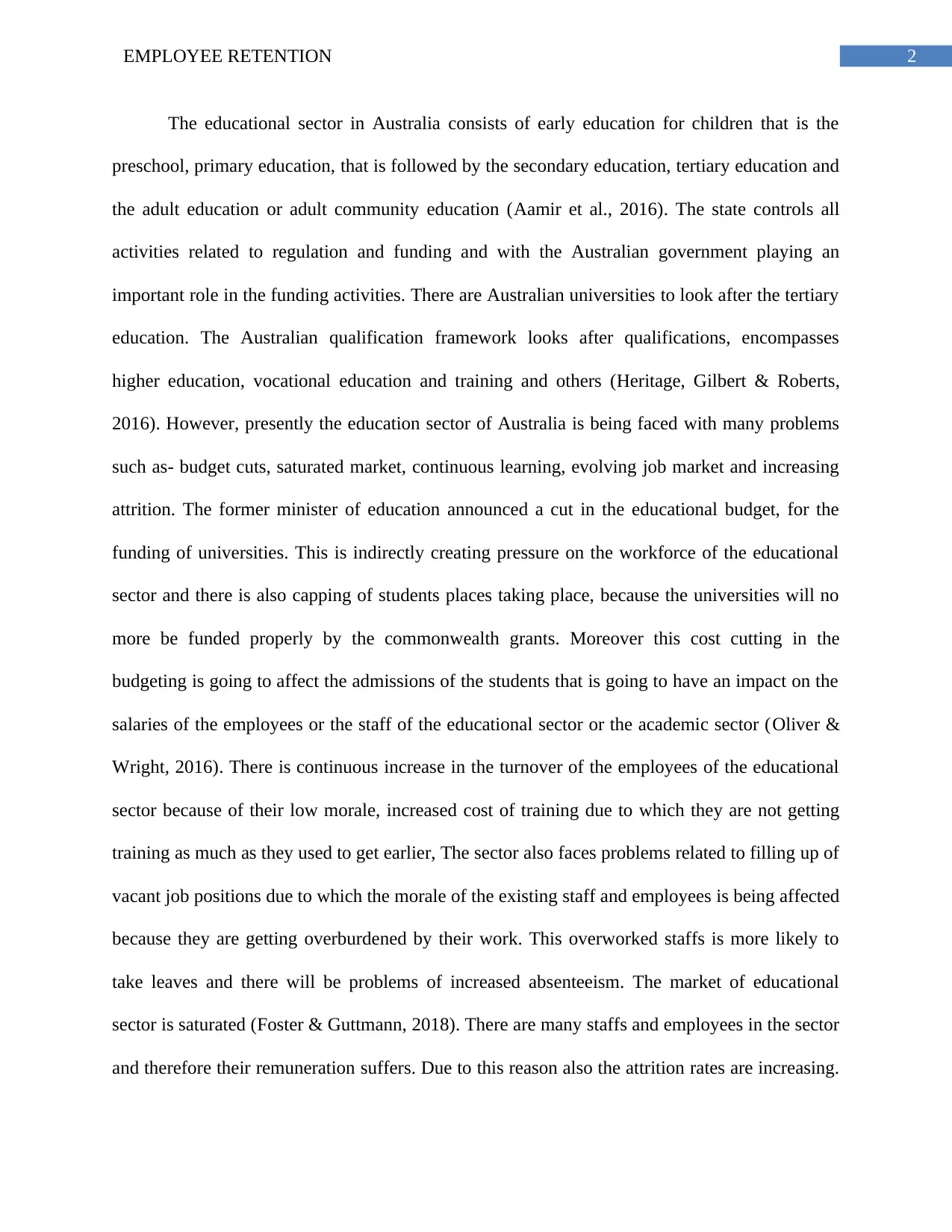
2EMPLOYEE RETENTION
The educational sector in Australia consists of early education for children that is the
preschool, primary education, that is followed by the secondary education, tertiary education and
the adult education or adult community education (Aamir et al., 2016). The state controls all
activities related to regulation and funding and with the Australian government playing an
important role in the funding activities. There are Australian universities to look after the tertiary
education. The Australian qualification framework looks after qualifications, encompasses
higher education, vocational education and training and others (Heritage, Gilbert & Roberts,
2016). However, presently the education sector of Australia is being faced with many problems
such as- budget cuts, saturated market, continuous learning, evolving job market and increasing
attrition. The former minister of education announced a cut in the educational budget, for the
funding of universities. This is indirectly creating pressure on the workforce of the educational
sector and there is also capping of students places taking place, because the universities will no
more be funded properly by the commonwealth grants. Moreover this cost cutting in the
budgeting is going to affect the admissions of the students that is going to have an impact on the
salaries of the employees or the staff of the educational sector or the academic sector (Oliver &
Wright, 2016). There is continuous increase in the turnover of the employees of the educational
sector because of their low morale, increased cost of training due to which they are not getting
training as much as they used to get earlier, The sector also faces problems related to filling up of
vacant job positions due to which the morale of the existing staff and employees is being affected
because they are getting overburdened by their work. This overworked staffs is more likely to
take leaves and there will be problems of increased absenteeism. The market of educational
sector is saturated (Foster & Guttmann, 2018). There are many staffs and employees in the sector
and therefore their remuneration suffers. Due to this reason also the attrition rates are increasing.
The educational sector in Australia consists of early education for children that is the
preschool, primary education, that is followed by the secondary education, tertiary education and
the adult education or adult community education (Aamir et al., 2016). The state controls all
activities related to regulation and funding and with the Australian government playing an
important role in the funding activities. There are Australian universities to look after the tertiary
education. The Australian qualification framework looks after qualifications, encompasses
higher education, vocational education and training and others (Heritage, Gilbert & Roberts,
2016). However, presently the education sector of Australia is being faced with many problems
such as- budget cuts, saturated market, continuous learning, evolving job market and increasing
attrition. The former minister of education announced a cut in the educational budget, for the
funding of universities. This is indirectly creating pressure on the workforce of the educational
sector and there is also capping of students places taking place, because the universities will no
more be funded properly by the commonwealth grants. Moreover this cost cutting in the
budgeting is going to affect the admissions of the students that is going to have an impact on the
salaries of the employees or the staff of the educational sector or the academic sector (Oliver &
Wright, 2016). There is continuous increase in the turnover of the employees of the educational
sector because of their low morale, increased cost of training due to which they are not getting
training as much as they used to get earlier, The sector also faces problems related to filling up of
vacant job positions due to which the morale of the existing staff and employees is being affected
because they are getting overburdened by their work. This overworked staffs is more likely to
take leaves and there will be problems of increased absenteeism. The market of educational
sector is saturated (Foster & Guttmann, 2018). There are many staffs and employees in the sector
and therefore their remuneration suffers. Due to this reason also the attrition rates are increasing.
⊘ This is a preview!⊘
Do you want full access?
Subscribe today to unlock all pages.

Trusted by 1+ million students worldwide
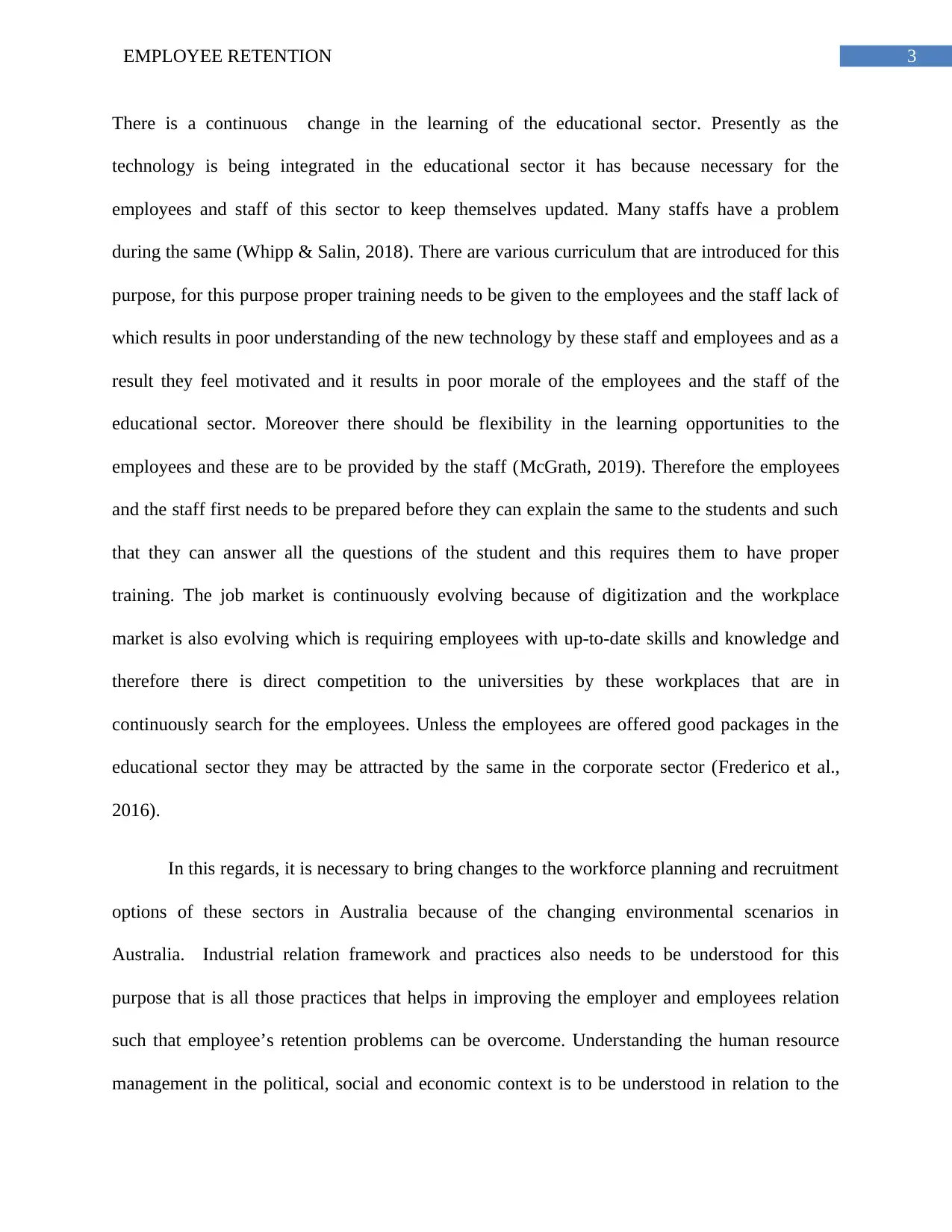
3EMPLOYEE RETENTION
There is a continuous change in the learning of the educational sector. Presently as the
technology is being integrated in the educational sector it has because necessary for the
employees and staff of this sector to keep themselves updated. Many staffs have a problem
during the same (Whipp & Salin, 2018). There are various curriculum that are introduced for this
purpose, for this purpose proper training needs to be given to the employees and the staff lack of
which results in poor understanding of the new technology by these staff and employees and as a
result they feel motivated and it results in poor morale of the employees and the staff of the
educational sector. Moreover there should be flexibility in the learning opportunities to the
employees and these are to be provided by the staff (McGrath, 2019). Therefore the employees
and the staff first needs to be prepared before they can explain the same to the students and such
that they can answer all the questions of the student and this requires them to have proper
training. The job market is continuously evolving because of digitization and the workplace
market is also evolving which is requiring employees with up-to-date skills and knowledge and
therefore there is direct competition to the universities by these workplaces that are in
continuously search for the employees. Unless the employees are offered good packages in the
educational sector they may be attracted by the same in the corporate sector (Frederico et al.,
2016).
In this regards, it is necessary to bring changes to the workforce planning and recruitment
options of these sectors in Australia because of the changing environmental scenarios in
Australia. Industrial relation framework and practices also needs to be understood for this
purpose that is all those practices that helps in improving the employer and employees relation
such that employee’s retention problems can be overcome. Understanding the human resource
management in the political, social and economic context is to be understood in relation to the
There is a continuous change in the learning of the educational sector. Presently as the
technology is being integrated in the educational sector it has because necessary for the
employees and staff of this sector to keep themselves updated. Many staffs have a problem
during the same (Whipp & Salin, 2018). There are various curriculum that are introduced for this
purpose, for this purpose proper training needs to be given to the employees and the staff lack of
which results in poor understanding of the new technology by these staff and employees and as a
result they feel motivated and it results in poor morale of the employees and the staff of the
educational sector. Moreover there should be flexibility in the learning opportunities to the
employees and these are to be provided by the staff (McGrath, 2019). Therefore the employees
and the staff first needs to be prepared before they can explain the same to the students and such
that they can answer all the questions of the student and this requires them to have proper
training. The job market is continuously evolving because of digitization and the workplace
market is also evolving which is requiring employees with up-to-date skills and knowledge and
therefore there is direct competition to the universities by these workplaces that are in
continuously search for the employees. Unless the employees are offered good packages in the
educational sector they may be attracted by the same in the corporate sector (Frederico et al.,
2016).
In this regards, it is necessary to bring changes to the workforce planning and recruitment
options of these sectors in Australia because of the changing environmental scenarios in
Australia. Industrial relation framework and practices also needs to be understood for this
purpose that is all those practices that helps in improving the employer and employees relation
such that employee’s retention problems can be overcome. Understanding the human resource
management in the political, social and economic context is to be understood in relation to the
Paraphrase This Document
Need a fresh take? Get an instant paraphrase of this document with our AI Paraphraser
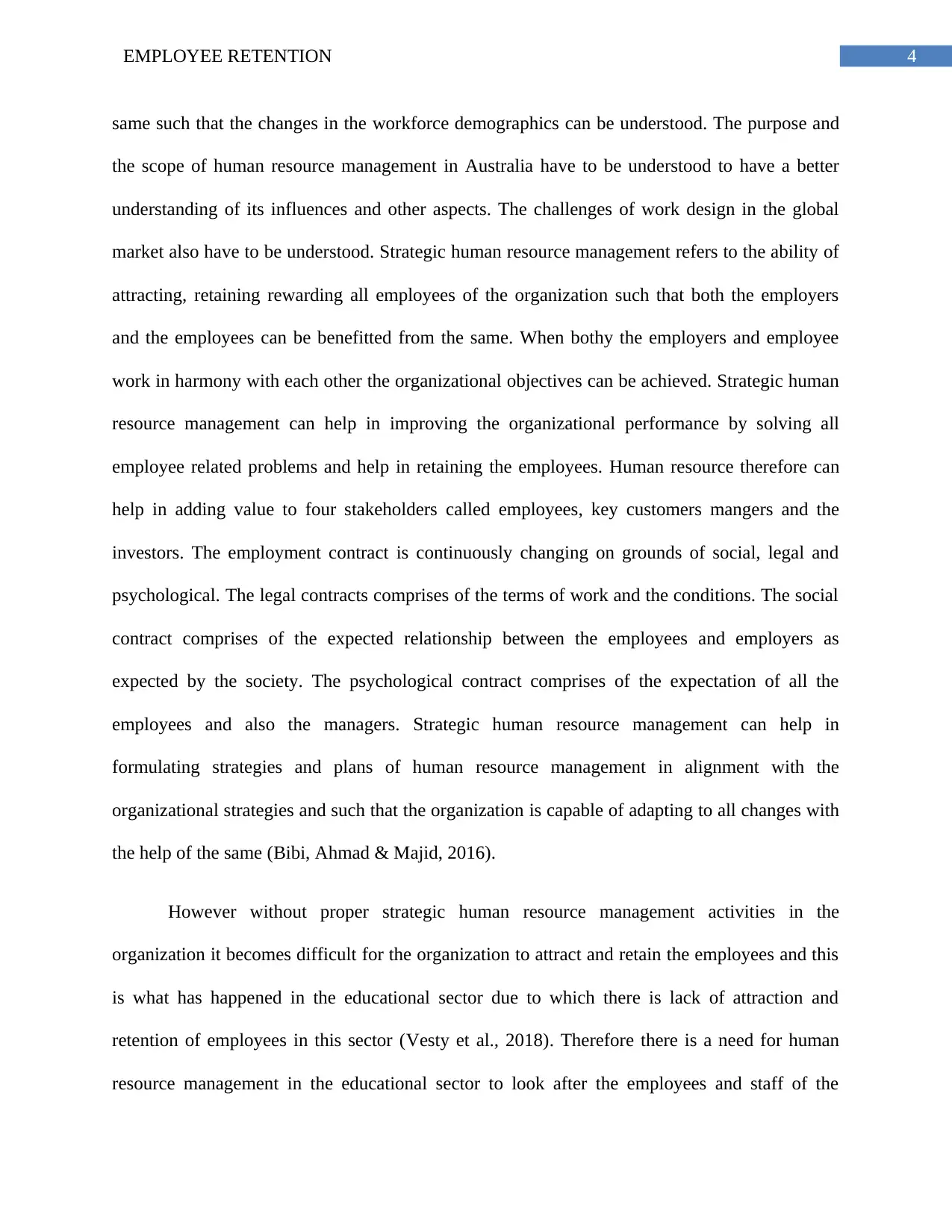
4EMPLOYEE RETENTION
same such that the changes in the workforce demographics can be understood. The purpose and
the scope of human resource management in Australia have to be understood to have a better
understanding of its influences and other aspects. The challenges of work design in the global
market also have to be understood. Strategic human resource management refers to the ability of
attracting, retaining rewarding all employees of the organization such that both the employers
and the employees can be benefitted from the same. When bothy the employers and employee
work in harmony with each other the organizational objectives can be achieved. Strategic human
resource management can help in improving the organizational performance by solving all
employee related problems and help in retaining the employees. Human resource therefore can
help in adding value to four stakeholders called employees, key customers mangers and the
investors. The employment contract is continuously changing on grounds of social, legal and
psychological. The legal contracts comprises of the terms of work and the conditions. The social
contract comprises of the expected relationship between the employees and employers as
expected by the society. The psychological contract comprises of the expectation of all the
employees and also the managers. Strategic human resource management can help in
formulating strategies and plans of human resource management in alignment with the
organizational strategies and such that the organization is capable of adapting to all changes with
the help of the same (Bibi, Ahmad & Majid, 2016).
However without proper strategic human resource management activities in the
organization it becomes difficult for the organization to attract and retain the employees and this
is what has happened in the educational sector due to which there is lack of attraction and
retention of employees in this sector (Vesty et al., 2018). Therefore there is a need for human
resource management in the educational sector to look after the employees and staff of the
same such that the changes in the workforce demographics can be understood. The purpose and
the scope of human resource management in Australia have to be understood to have a better
understanding of its influences and other aspects. The challenges of work design in the global
market also have to be understood. Strategic human resource management refers to the ability of
attracting, retaining rewarding all employees of the organization such that both the employers
and the employees can be benefitted from the same. When bothy the employers and employee
work in harmony with each other the organizational objectives can be achieved. Strategic human
resource management can help in improving the organizational performance by solving all
employee related problems and help in retaining the employees. Human resource therefore can
help in adding value to four stakeholders called employees, key customers mangers and the
investors. The employment contract is continuously changing on grounds of social, legal and
psychological. The legal contracts comprises of the terms of work and the conditions. The social
contract comprises of the expected relationship between the employees and employers as
expected by the society. The psychological contract comprises of the expectation of all the
employees and also the managers. Strategic human resource management can help in
formulating strategies and plans of human resource management in alignment with the
organizational strategies and such that the organization is capable of adapting to all changes with
the help of the same (Bibi, Ahmad & Majid, 2016).
However without proper strategic human resource management activities in the
organization it becomes difficult for the organization to attract and retain the employees and this
is what has happened in the educational sector due to which there is lack of attraction and
retention of employees in this sector (Vesty et al., 2018). Therefore there is a need for human
resource management in the educational sector to look after the employees and staff of the
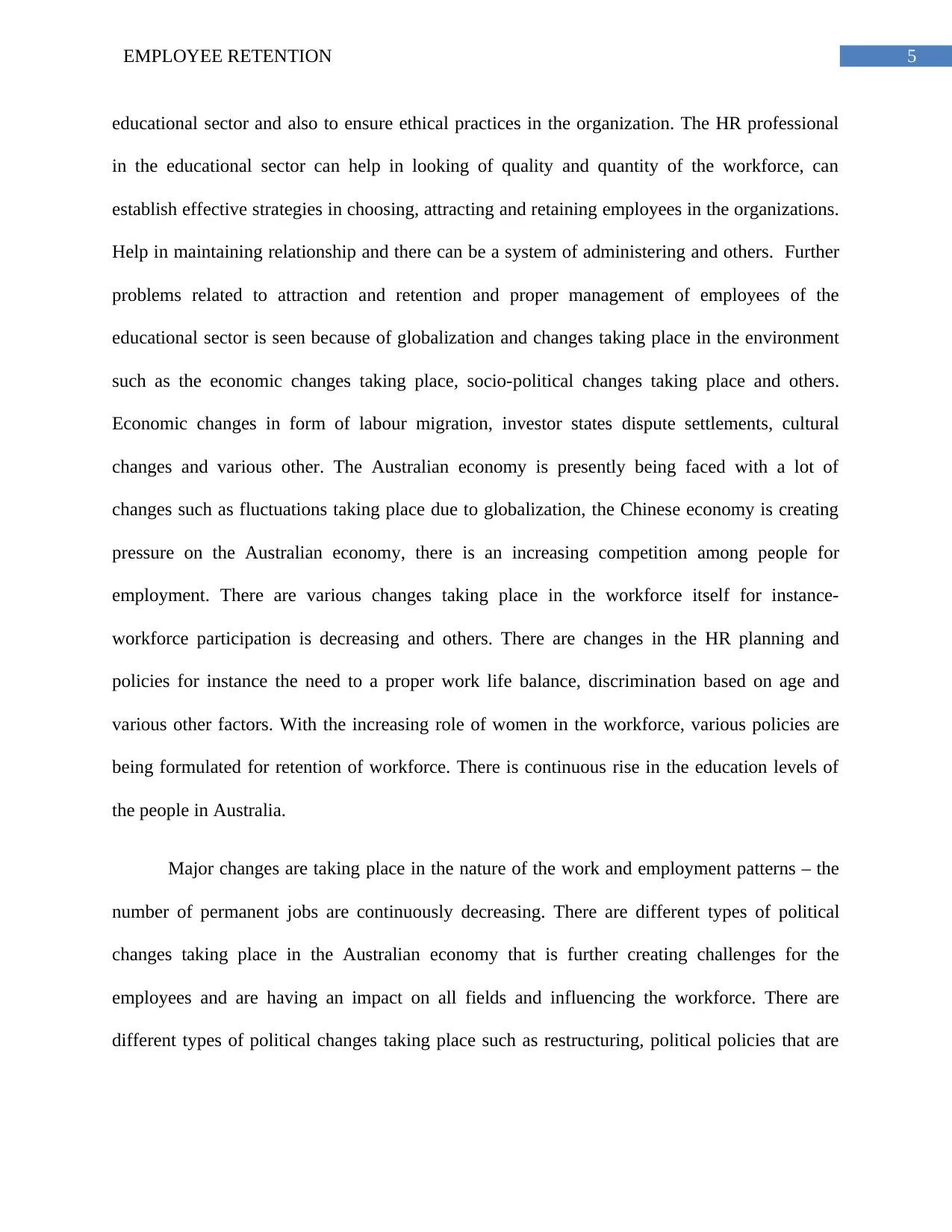
5EMPLOYEE RETENTION
educational sector and also to ensure ethical practices in the organization. The HR professional
in the educational sector can help in looking of quality and quantity of the workforce, can
establish effective strategies in choosing, attracting and retaining employees in the organizations.
Help in maintaining relationship and there can be a system of administering and others. Further
problems related to attraction and retention and proper management of employees of the
educational sector is seen because of globalization and changes taking place in the environment
such as the economic changes taking place, socio-political changes taking place and others.
Economic changes in form of labour migration, investor states dispute settlements, cultural
changes and various other. The Australian economy is presently being faced with a lot of
changes such as fluctuations taking place due to globalization, the Chinese economy is creating
pressure on the Australian economy, there is an increasing competition among people for
employment. There are various changes taking place in the workforce itself for instance-
workforce participation is decreasing and others. There are changes in the HR planning and
policies for instance the need to a proper work life balance, discrimination based on age and
various other factors. With the increasing role of women in the workforce, various policies are
being formulated for retention of workforce. There is continuous rise in the education levels of
the people in Australia.
Major changes are taking place in the nature of the work and employment patterns – the
number of permanent jobs are continuously decreasing. There are different types of political
changes taking place in the Australian economy that is further creating challenges for the
employees and are having an impact on all fields and influencing the workforce. There are
different types of political changes taking place such as restructuring, political policies that are
educational sector and also to ensure ethical practices in the organization. The HR professional
in the educational sector can help in looking of quality and quantity of the workforce, can
establish effective strategies in choosing, attracting and retaining employees in the organizations.
Help in maintaining relationship and there can be a system of administering and others. Further
problems related to attraction and retention and proper management of employees of the
educational sector is seen because of globalization and changes taking place in the environment
such as the economic changes taking place, socio-political changes taking place and others.
Economic changes in form of labour migration, investor states dispute settlements, cultural
changes and various other. The Australian economy is presently being faced with a lot of
changes such as fluctuations taking place due to globalization, the Chinese economy is creating
pressure on the Australian economy, there is an increasing competition among people for
employment. There are various changes taking place in the workforce itself for instance-
workforce participation is decreasing and others. There are changes in the HR planning and
policies for instance the need to a proper work life balance, discrimination based on age and
various other factors. With the increasing role of women in the workforce, various policies are
being formulated for retention of workforce. There is continuous rise in the education levels of
the people in Australia.
Major changes are taking place in the nature of the work and employment patterns – the
number of permanent jobs are continuously decreasing. There are different types of political
changes taking place in the Australian economy that is further creating challenges for the
employees and are having an impact on all fields and influencing the workforce. There are
different types of political changes taking place such as restructuring, political policies that are
⊘ This is a preview!⊘
Do you want full access?
Subscribe today to unlock all pages.

Trusted by 1+ million students worldwide
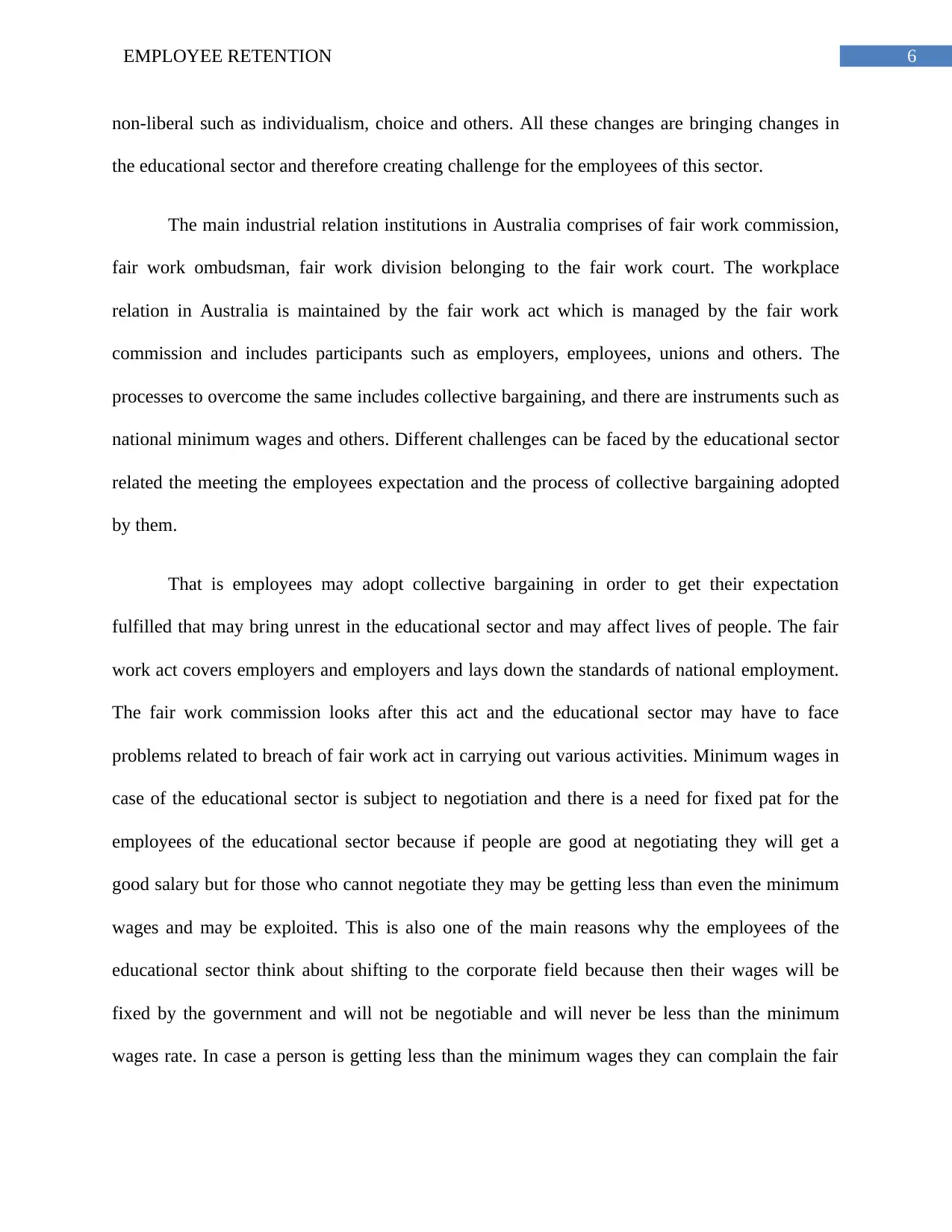
6EMPLOYEE RETENTION
non-liberal such as individualism, choice and others. All these changes are bringing changes in
the educational sector and therefore creating challenge for the employees of this sector.
The main industrial relation institutions in Australia comprises of fair work commission,
fair work ombudsman, fair work division belonging to the fair work court. The workplace
relation in Australia is maintained by the fair work act which is managed by the fair work
commission and includes participants such as employers, employees, unions and others. The
processes to overcome the same includes collective bargaining, and there are instruments such as
national minimum wages and others. Different challenges can be faced by the educational sector
related the meeting the employees expectation and the process of collective bargaining adopted
by them.
That is employees may adopt collective bargaining in order to get their expectation
fulfilled that may bring unrest in the educational sector and may affect lives of people. The fair
work act covers employers and employers and lays down the standards of national employment.
The fair work commission looks after this act and the educational sector may have to face
problems related to breach of fair work act in carrying out various activities. Minimum wages in
case of the educational sector is subject to negotiation and there is a need for fixed pat for the
employees of the educational sector because if people are good at negotiating they will get a
good salary but for those who cannot negotiate they may be getting less than even the minimum
wages and may be exploited. This is also one of the main reasons why the employees of the
educational sector think about shifting to the corporate field because then their wages will be
fixed by the government and will not be negotiable and will never be less than the minimum
wages rate. In case a person is getting less than the minimum wages they can complain the fair
non-liberal such as individualism, choice and others. All these changes are bringing changes in
the educational sector and therefore creating challenge for the employees of this sector.
The main industrial relation institutions in Australia comprises of fair work commission,
fair work ombudsman, fair work division belonging to the fair work court. The workplace
relation in Australia is maintained by the fair work act which is managed by the fair work
commission and includes participants such as employers, employees, unions and others. The
processes to overcome the same includes collective bargaining, and there are instruments such as
national minimum wages and others. Different challenges can be faced by the educational sector
related the meeting the employees expectation and the process of collective bargaining adopted
by them.
That is employees may adopt collective bargaining in order to get their expectation
fulfilled that may bring unrest in the educational sector and may affect lives of people. The fair
work act covers employers and employers and lays down the standards of national employment.
The fair work commission looks after this act and the educational sector may have to face
problems related to breach of fair work act in carrying out various activities. Minimum wages in
case of the educational sector is subject to negotiation and there is a need for fixed pat for the
employees of the educational sector because if people are good at negotiating they will get a
good salary but for those who cannot negotiate they may be getting less than even the minimum
wages and may be exploited. This is also one of the main reasons why the employees of the
educational sector think about shifting to the corporate field because then their wages will be
fixed by the government and will not be negotiable and will never be less than the minimum
wages rate. In case a person is getting less than the minimum wages they can complain the fair
Paraphrase This Document
Need a fresh take? Get an instant paraphrase of this document with our AI Paraphraser
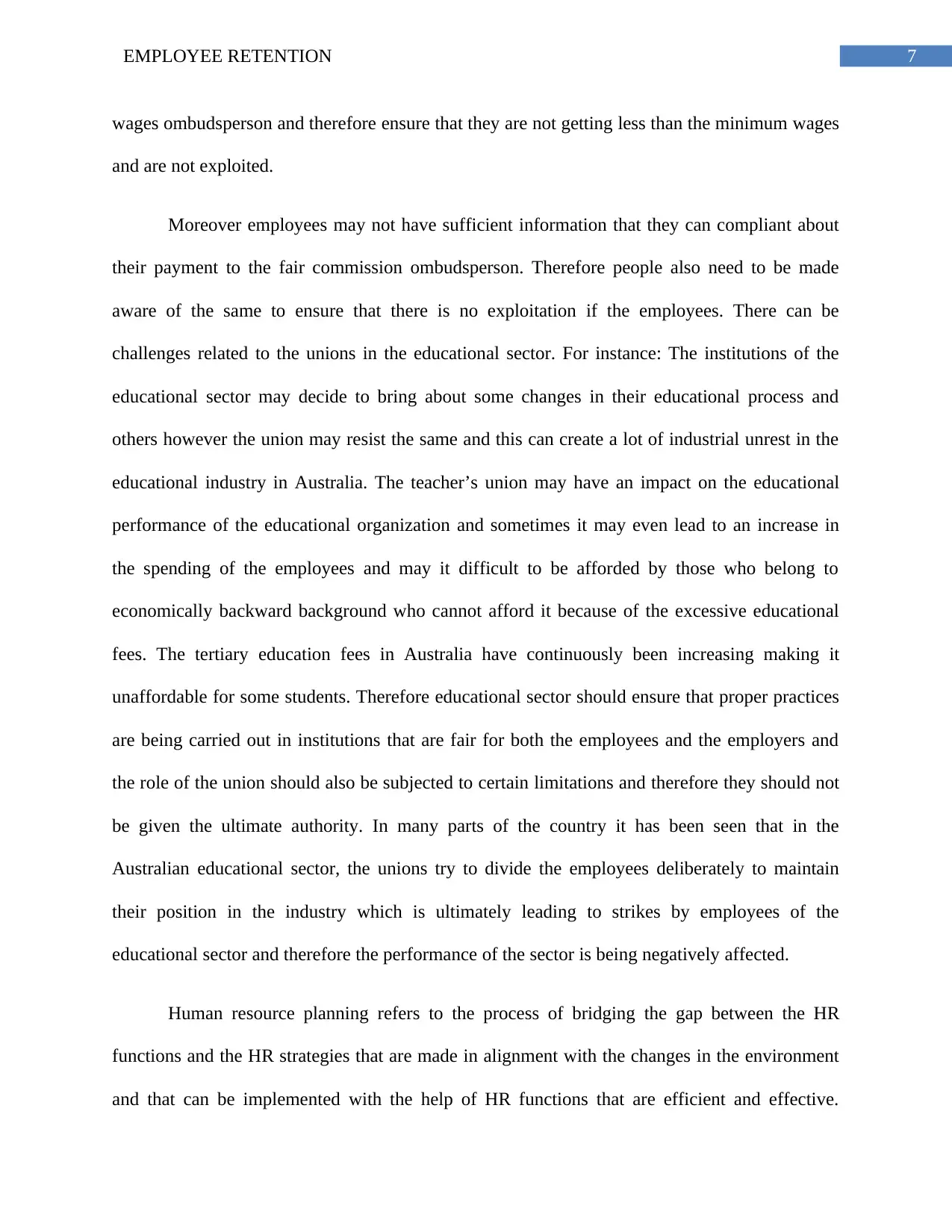
7EMPLOYEE RETENTION
wages ombudsperson and therefore ensure that they are not getting less than the minimum wages
and are not exploited.
Moreover employees may not have sufficient information that they can compliant about
their payment to the fair commission ombudsperson. Therefore people also need to be made
aware of the same to ensure that there is no exploitation if the employees. There can be
challenges related to the unions in the educational sector. For instance: The institutions of the
educational sector may decide to bring about some changes in their educational process and
others however the union may resist the same and this can create a lot of industrial unrest in the
educational industry in Australia. The teacher’s union may have an impact on the educational
performance of the educational organization and sometimes it may even lead to an increase in
the spending of the employees and may it difficult to be afforded by those who belong to
economically backward background who cannot afford it because of the excessive educational
fees. The tertiary education fees in Australia have continuously been increasing making it
unaffordable for some students. Therefore educational sector should ensure that proper practices
are being carried out in institutions that are fair for both the employees and the employers and
the role of the union should also be subjected to certain limitations and therefore they should not
be given the ultimate authority. In many parts of the country it has been seen that in the
Australian educational sector, the unions try to divide the employees deliberately to maintain
their position in the industry which is ultimately leading to strikes by employees of the
educational sector and therefore the performance of the sector is being negatively affected.
Human resource planning refers to the process of bridging the gap between the HR
functions and the HR strategies that are made in alignment with the changes in the environment
and that can be implemented with the help of HR functions that are efficient and effective.
wages ombudsperson and therefore ensure that they are not getting less than the minimum wages
and are not exploited.
Moreover employees may not have sufficient information that they can compliant about
their payment to the fair commission ombudsperson. Therefore people also need to be made
aware of the same to ensure that there is no exploitation if the employees. There can be
challenges related to the unions in the educational sector. For instance: The institutions of the
educational sector may decide to bring about some changes in their educational process and
others however the union may resist the same and this can create a lot of industrial unrest in the
educational industry in Australia. The teacher’s union may have an impact on the educational
performance of the educational organization and sometimes it may even lead to an increase in
the spending of the employees and may it difficult to be afforded by those who belong to
economically backward background who cannot afford it because of the excessive educational
fees. The tertiary education fees in Australia have continuously been increasing making it
unaffordable for some students. Therefore educational sector should ensure that proper practices
are being carried out in institutions that are fair for both the employees and the employers and
the role of the union should also be subjected to certain limitations and therefore they should not
be given the ultimate authority. In many parts of the country it has been seen that in the
Australian educational sector, the unions try to divide the employees deliberately to maintain
their position in the industry which is ultimately leading to strikes by employees of the
educational sector and therefore the performance of the sector is being negatively affected.
Human resource planning refers to the process of bridging the gap between the HR
functions and the HR strategies that are made in alignment with the changes in the environment
and that can be implemented with the help of HR functions that are efficient and effective.
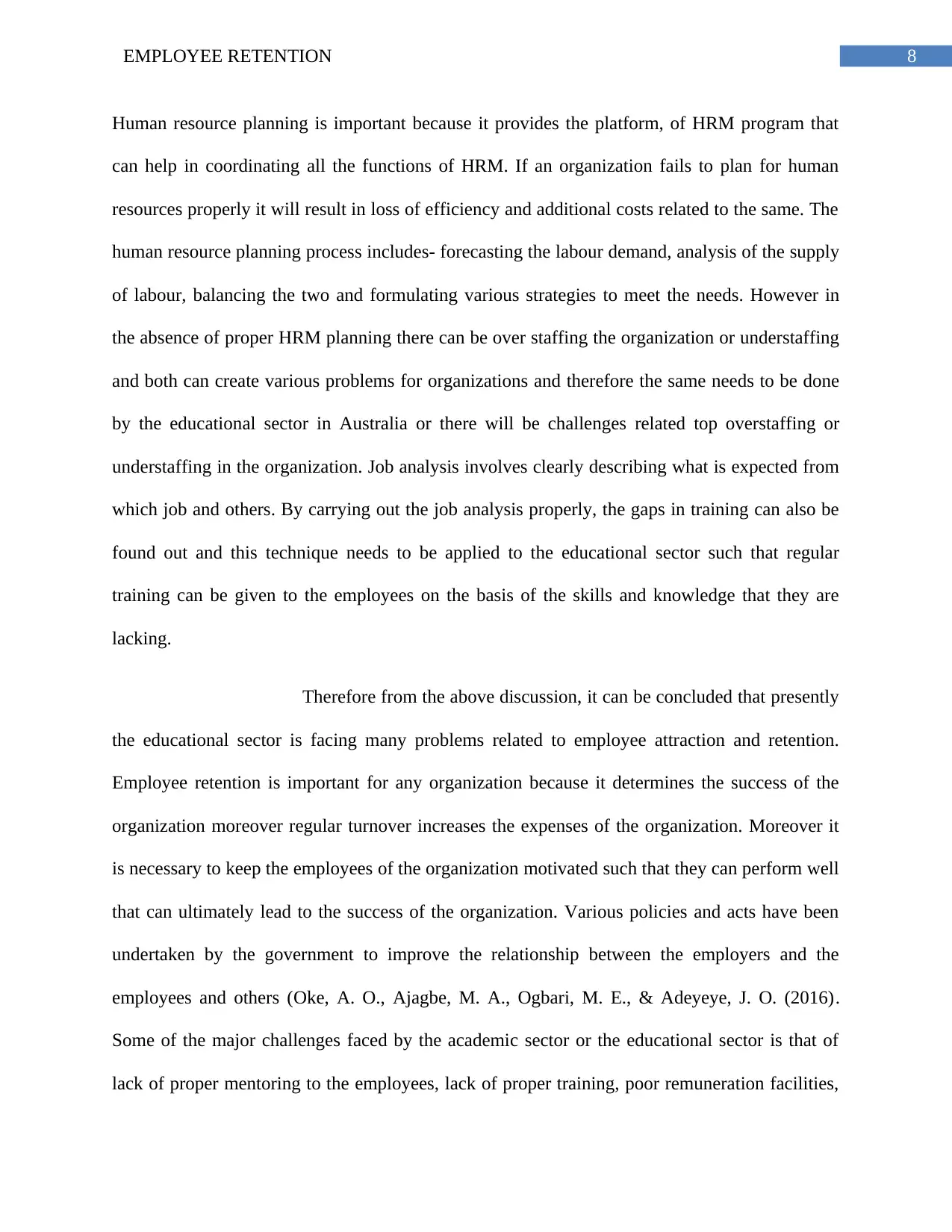
8EMPLOYEE RETENTION
Human resource planning is important because it provides the platform, of HRM program that
can help in coordinating all the functions of HRM. If an organization fails to plan for human
resources properly it will result in loss of efficiency and additional costs related to the same. The
human resource planning process includes- forecasting the labour demand, analysis of the supply
of labour, balancing the two and formulating various strategies to meet the needs. However in
the absence of proper HRM planning there can be over staffing the organization or understaffing
and both can create various problems for organizations and therefore the same needs to be done
by the educational sector in Australia or there will be challenges related top overstaffing or
understaffing in the organization. Job analysis involves clearly describing what is expected from
which job and others. By carrying out the job analysis properly, the gaps in training can also be
found out and this technique needs to be applied to the educational sector such that regular
training can be given to the employees on the basis of the skills and knowledge that they are
lacking.
Therefore from the above discussion, it can be concluded that presently
the educational sector is facing many problems related to employee attraction and retention.
Employee retention is important for any organization because it determines the success of the
organization moreover regular turnover increases the expenses of the organization. Moreover it
is necessary to keep the employees of the organization motivated such that they can perform well
that can ultimately lead to the success of the organization. Various policies and acts have been
undertaken by the government to improve the relationship between the employers and the
employees and others (Oke, A. O., Ajagbe, M. A., Ogbari, M. E., & Adeyeye, J. O. (2016).
Some of the major challenges faced by the academic sector or the educational sector is that of
lack of proper mentoring to the employees, lack of proper training, poor remuneration facilities,
Human resource planning is important because it provides the platform, of HRM program that
can help in coordinating all the functions of HRM. If an organization fails to plan for human
resources properly it will result in loss of efficiency and additional costs related to the same. The
human resource planning process includes- forecasting the labour demand, analysis of the supply
of labour, balancing the two and formulating various strategies to meet the needs. However in
the absence of proper HRM planning there can be over staffing the organization or understaffing
and both can create various problems for organizations and therefore the same needs to be done
by the educational sector in Australia or there will be challenges related top overstaffing or
understaffing in the organization. Job analysis involves clearly describing what is expected from
which job and others. By carrying out the job analysis properly, the gaps in training can also be
found out and this technique needs to be applied to the educational sector such that regular
training can be given to the employees on the basis of the skills and knowledge that they are
lacking.
Therefore from the above discussion, it can be concluded that presently
the educational sector is facing many problems related to employee attraction and retention.
Employee retention is important for any organization because it determines the success of the
organization moreover regular turnover increases the expenses of the organization. Moreover it
is necessary to keep the employees of the organization motivated such that they can perform well
that can ultimately lead to the success of the organization. Various policies and acts have been
undertaken by the government to improve the relationship between the employers and the
employees and others (Oke, A. O., Ajagbe, M. A., Ogbari, M. E., & Adeyeye, J. O. (2016).
Some of the major challenges faced by the academic sector or the educational sector is that of
lack of proper mentoring to the employees, lack of proper training, poor remuneration facilities,
⊘ This is a preview!⊘
Do you want full access?
Subscribe today to unlock all pages.

Trusted by 1+ million students worldwide
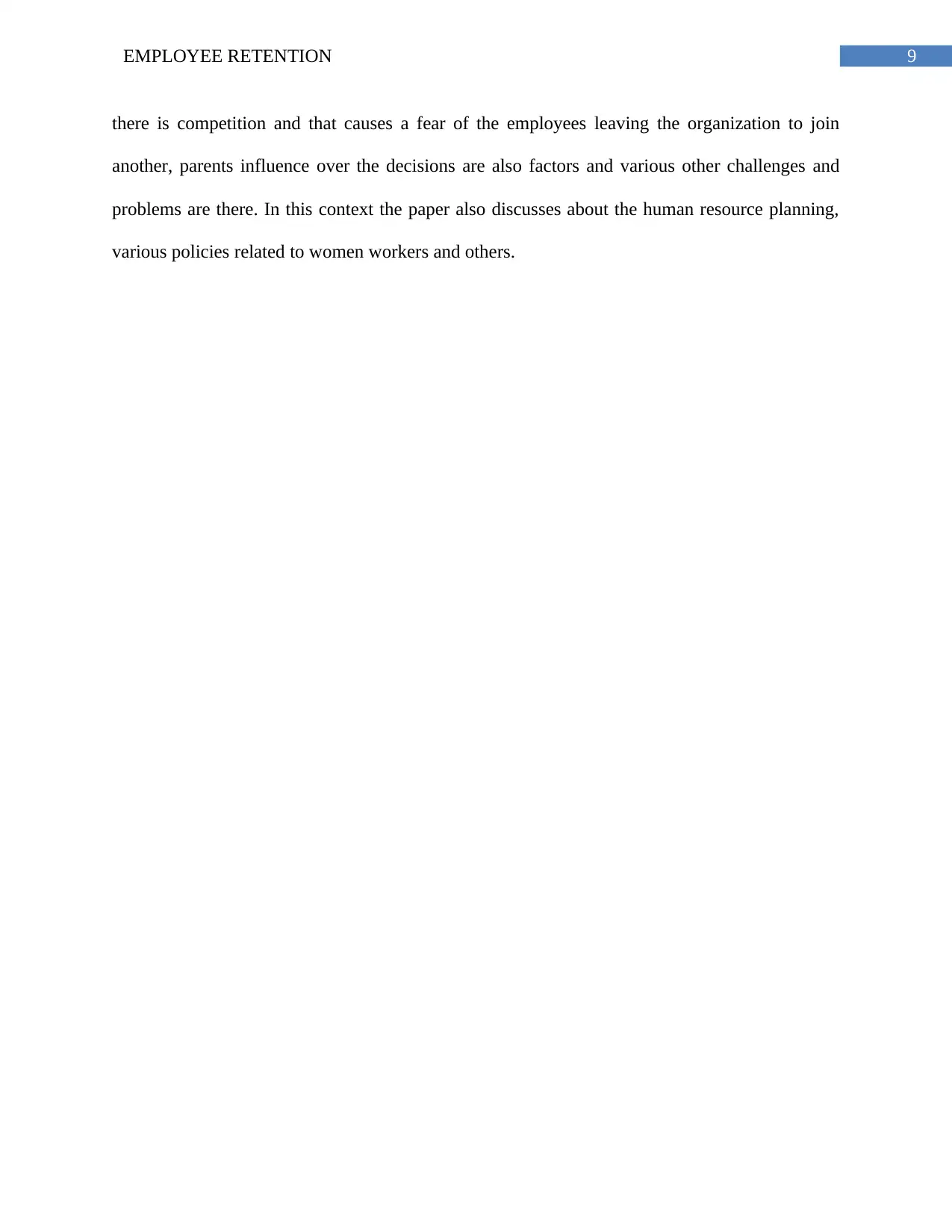
9EMPLOYEE RETENTION
there is competition and that causes a fear of the employees leaving the organization to join
another, parents influence over the decisions are also factors and various other challenges and
problems are there. In this context the paper also discusses about the human resource planning,
various policies related to women workers and others.
there is competition and that causes a fear of the employees leaving the organization to join
another, parents influence over the decisions are also factors and various other challenges and
problems are there. In this context the paper also discusses about the human resource planning,
various policies related to women workers and others.
Paraphrase This Document
Need a fresh take? Get an instant paraphrase of this document with our AI Paraphraser
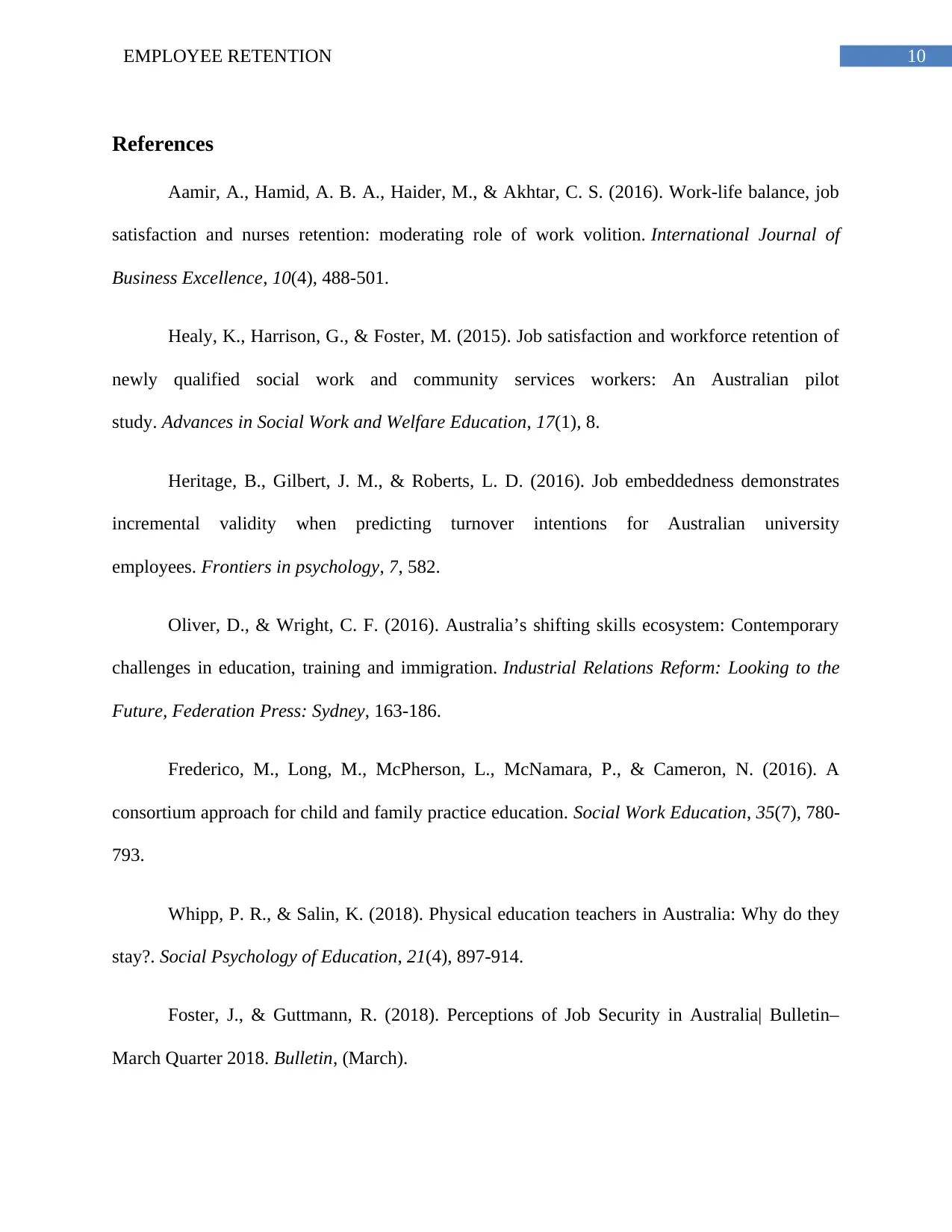
10EMPLOYEE RETENTION
References
Aamir, A., Hamid, A. B. A., Haider, M., & Akhtar, C. S. (2016). Work-life balance, job
satisfaction and nurses retention: moderating role of work volition. International Journal of
Business Excellence, 10(4), 488-501.
Healy, K., Harrison, G., & Foster, M. (2015). Job satisfaction and workforce retention of
newly qualified social work and community services workers: An Australian pilot
study. Advances in Social Work and Welfare Education, 17(1), 8.
Heritage, B., Gilbert, J. M., & Roberts, L. D. (2016). Job embeddedness demonstrates
incremental validity when predicting turnover intentions for Australian university
employees. Frontiers in psychology, 7, 582.
Oliver, D., & Wright, C. F. (2016). Australia’s shifting skills ecosystem: Contemporary
challenges in education, training and immigration. Industrial Relations Reform: Looking to the
Future, Federation Press: Sydney, 163-186.
Frederico, M., Long, M., McPherson, L., McNamara, P., & Cameron, N. (2016). A
consortium approach for child and family practice education. Social Work Education, 35(7), 780-
793.
Whipp, P. R., & Salin, K. (2018). Physical education teachers in Australia: Why do they
stay?. Social Psychology of Education, 21(4), 897-914.
Foster, J., & Guttmann, R. (2018). Perceptions of Job Security in Australia| Bulletin–
March Quarter 2018. Bulletin, (March).
References
Aamir, A., Hamid, A. B. A., Haider, M., & Akhtar, C. S. (2016). Work-life balance, job
satisfaction and nurses retention: moderating role of work volition. International Journal of
Business Excellence, 10(4), 488-501.
Healy, K., Harrison, G., & Foster, M. (2015). Job satisfaction and workforce retention of
newly qualified social work and community services workers: An Australian pilot
study. Advances in Social Work and Welfare Education, 17(1), 8.
Heritage, B., Gilbert, J. M., & Roberts, L. D. (2016). Job embeddedness demonstrates
incremental validity when predicting turnover intentions for Australian university
employees. Frontiers in psychology, 7, 582.
Oliver, D., & Wright, C. F. (2016). Australia’s shifting skills ecosystem: Contemporary
challenges in education, training and immigration. Industrial Relations Reform: Looking to the
Future, Federation Press: Sydney, 163-186.
Frederico, M., Long, M., McPherson, L., McNamara, P., & Cameron, N. (2016). A
consortium approach for child and family practice education. Social Work Education, 35(7), 780-
793.
Whipp, P. R., & Salin, K. (2018). Physical education teachers in Australia: Why do they
stay?. Social Psychology of Education, 21(4), 897-914.
Foster, J., & Guttmann, R. (2018). Perceptions of Job Security in Australia| Bulletin–
March Quarter 2018. Bulletin, (March).
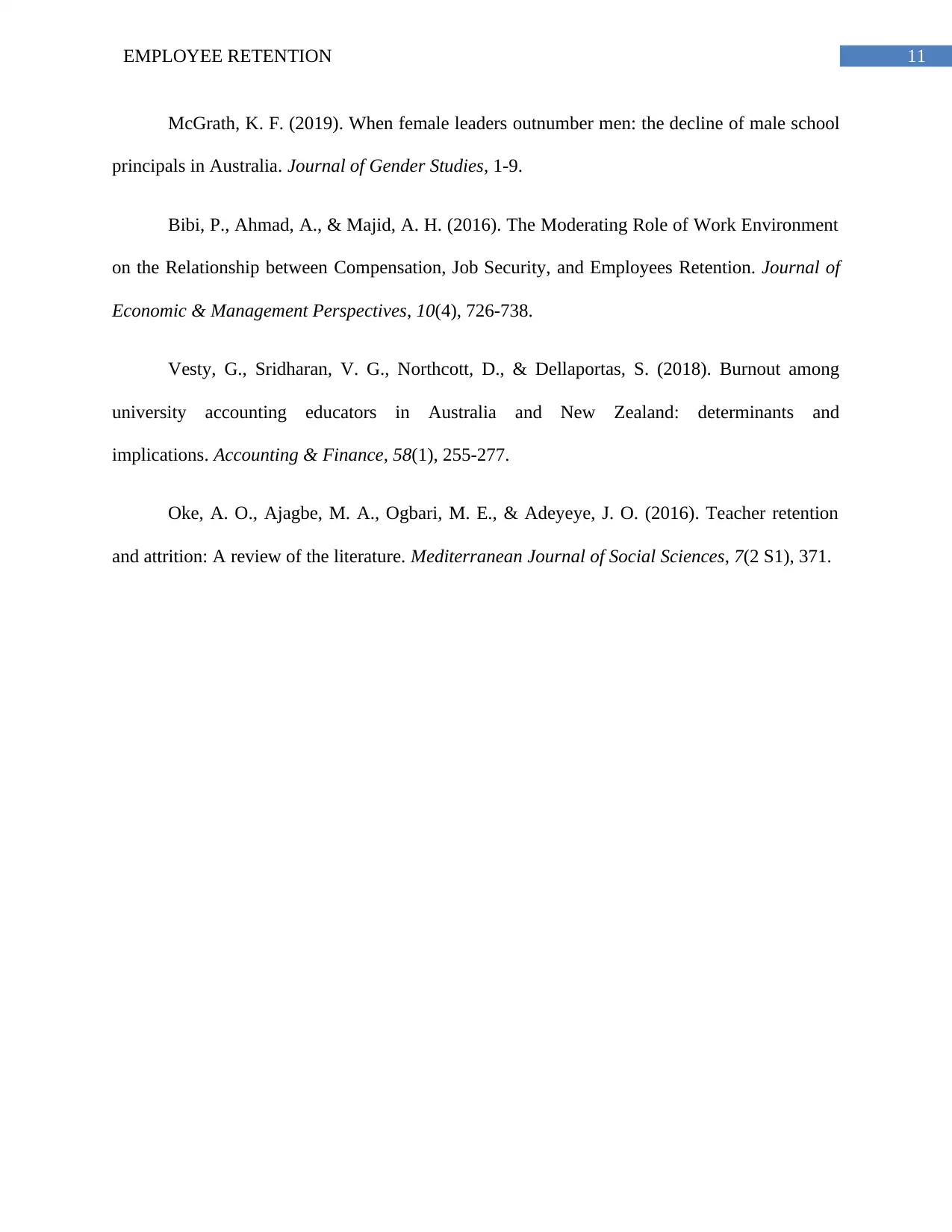
11EMPLOYEE RETENTION
McGrath, K. F. (2019). When female leaders outnumber men: the decline of male school
principals in Australia. Journal of Gender Studies, 1-9.
Bibi, P., Ahmad, A., & Majid, A. H. (2016). The Moderating Role of Work Environment
on the Relationship between Compensation, Job Security, and Employees Retention. Journal of
Economic & Management Perspectives, 10(4), 726-738.
Vesty, G., Sridharan, V. G., Northcott, D., & Dellaportas, S. (2018). Burnout among
university accounting educators in Australia and New Zealand: determinants and
implications. Accounting & Finance, 58(1), 255-277.
Oke, A. O., Ajagbe, M. A., Ogbari, M. E., & Adeyeye, J. O. (2016). Teacher retention
and attrition: A review of the literature. Mediterranean Journal of Social Sciences, 7(2 S1), 371.
McGrath, K. F. (2019). When female leaders outnumber men: the decline of male school
principals in Australia. Journal of Gender Studies, 1-9.
Bibi, P., Ahmad, A., & Majid, A. H. (2016). The Moderating Role of Work Environment
on the Relationship between Compensation, Job Security, and Employees Retention. Journal of
Economic & Management Perspectives, 10(4), 726-738.
Vesty, G., Sridharan, V. G., Northcott, D., & Dellaportas, S. (2018). Burnout among
university accounting educators in Australia and New Zealand: determinants and
implications. Accounting & Finance, 58(1), 255-277.
Oke, A. O., Ajagbe, M. A., Ogbari, M. E., & Adeyeye, J. O. (2016). Teacher retention
and attrition: A review of the literature. Mediterranean Journal of Social Sciences, 7(2 S1), 371.
⊘ This is a preview!⊘
Do you want full access?
Subscribe today to unlock all pages.

Trusted by 1+ million students worldwide
1 out of 12
Related Documents
Your All-in-One AI-Powered Toolkit for Academic Success.
+13062052269
info@desklib.com
Available 24*7 on WhatsApp / Email
![[object Object]](/_next/static/media/star-bottom.7253800d.svg)
Unlock your academic potential
Copyright © 2020–2025 A2Z Services. All Rights Reserved. Developed and managed by ZUCOL.





